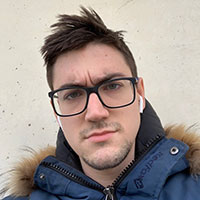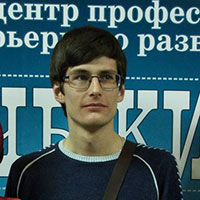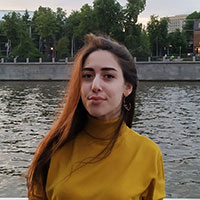A Robot Instead of a Term Paper: Four HSE Student Engineering Projects
Starting this academic year, hands-on project work has officially been incorporated into the MIEM educational programme curricula. Working within real-world professional parameters, current third-year students designed, soldered or coded projects for real clients. Once the students presented their projects at a final defense, a Tech Show was held at HSE University for the first time on June 10.
How do you make a 3D printer without a computer or create a programme to monitor brain activity using virtual reality technology? How do you accidently invent your own technology to produce printed circuit boards while working on a prototype? HSE students answered these questions and more as they presented their projects at the Tech Show.
Student teams presented 86 functional prototypes, i.e., engineering solutions to particular problems. Each project had a customer, a technical task and a completion deadline. Students not only created devices, but also developed related documentation, and presented their projects to potential clients.
The best works were presented at the exhibition on June 10, and some of them were demonstrated for the guests. All projects have been assessed by customers and competition committee. Representatives of MIEM partner companies also attended the event.
HSE News Service spoke with the student teams behind four projects that reflect the principles of the international approach to engineering education CDIO (Conceive-Design-Implement-Operate).
Conceive
Remote controlled unmanned underwater vehicle
Project head — Alexander Semion.
Team members: Dmitry Filin, Maxim Grigoriev, Egor Shalimov.
The goal of the team’s project, which was ordered by HSE University, was to provide a low-cost and effective device for exploring underwater space and examining engineering facilities. The remote-controlled device looks and moves—absolutely silently—like a real eel. It does not disturb water life and can reach areas that are otherwise inaccessible.
One of the key components of the project consisted of homemade printed circuit boards and a silicone frame. While the students managed to create the frame using a conventional heater, they had to experiment with the boards.

Dmitry Filin,
Team Leader
Initially, in order to get the light of a special film through a stencil, we used a manicure drying lamp, but then we built a more complex device with a timer. We could have made the boards at HSE, but it takes a lot of time to get there, and the technology was not that reliable. It is based on the mechanical removal of metal from the workpiece, and this limits the minimum size of the track on the board and can result in a hitch, a short circuit or simply the detachment of unnecessary metal. While the aesthetics of our device was not so important, we nonetheless needed to get flat tracks to apply the mask (a thin polymer green layer). In addition, the photolithographic method with the lamp still had to be used to protect the board from corrosion and mechanical damage.
Design
Storage and data processing system for housing and communal services
Project head — Eduard Klyshinsky.
Team members: Daniil Tekunov, Alexander Sukhobrusov, Alexander Chernyshov.
This project helps to create a single ecosystem for consumers, housing and communal services, and the banking sector. The system will collect and process meter data (i.e., electricity usage in Russian homes). The service will simplify work between housing and utility services and management companies, as well as allow the central banking office to work more effectively with payment information from different cities.

Team Leader
What made us most excited about this project was that the client was a major Russian bank. In addition, we were allowed to build our own service architecture — this was also a great incentive.
I always want to try out new technology and frameworks, but my main job doesn’t let me quickly create and test the project on production. So, for me, this service was an opportunity to learn something new.
As for working in a team, we knew each other before the project and even tried to code something together, so the process was almost intuitive. It turned out that everyone learned quickly what to do and how to do it.
Implement
Data search and analysis app for social media
Project head — Sergey Slastnikov.
Team members: Dmitry Ziganshin, Anton Bogatov, Olesya Gorokhovskaya, Gleb Mezentsev, Evgeny Panteleev, Nikita Sidorov.
The app allows users to track the activity of specified accounts. You can monitor posts by keywords, as well as determine the emotional connotations of a text and generate notification statistics. The application will help organizations simplify the process of analysis of social network data, determine the attitude of users to specific events, and summarize market research.

Nikita Sidorov,
Team Member
The task of determining the tone of a given text is often completed in English, so with Russian things are a bit more complicated. Almost everything that we originally planned to do didn't work, and we had to look for other ways to do it. It might seem that everything already exists on the Internet, but in fact it is not easy to find suitable methods for each task, much less implement them.
Difficulties mostly arose when preparing various reports—videos, presentations, posters and other things—since we had to pause working on our main project.
Operate
Raman spectrometer chip for space research
Project head — Grigory Goltsman.
Team members: Alexey Kuzin, Alexey Zybynov, Irina Elbakieva, Alexey Tarasov.
This project aimed to create an integrated optical raman spectrometer chip to determine the composition of a test substance. The project was requested by German aerospace centre DLR with the support of SCONTEL and Moscow State Pedagogical University. The device measures the radiation spectrum of chemical elements that make up a substance. This gives information about the substance composition, its origin or properties.

Irina Elbakieva,
Team Member
There was a lot of team work on a real project with cool customers, and we met a lot of new people. The only thing that we missed was the laboratory equipment in MIEM, as it is difficult to get access to the equipment at the enterprise, and it doesn’t always work well. But if we could come and twist the handles of the lithograph any time we needed, the result would have been better, and working process would have been more interesting, as we would have had more motivation.

Team Leader
In terms of commercial implementation, the project has great prospects. There currently is no raman spectrometer integrated onto a chip in the world yet, and we have almost developed it. First of all, the device is designed for research enterprises, laboratories, and universities. But in the future, a device for home use based on our spectrometer, which could determine the composition of products in a store, can be developed.
See also:
Scientarium: Integrating Student Scientific Associations and HSE University Projects
In early July, the Voronovo Study Centre hosted Scientarium, an off-site session for representatives of HSE University student research communities organised by the university’s Centre for Student Academic Development and Unit for the Popularisation of Science. More than 50 students from 10 scientific student associations and three campuses took part.
From Ingenious Fungi to Post-feminism: HSE University Hosts Season’s Last Science Battles Semi-Final
Season VI of Science Battles at HSE University is entering the homestretch. The June semi-final determined the list of finalists and helped many viewers choose their favourites. This time, young researchers decided to figure out how to conduct a police lineup without destroying a person’s life, as well as how to improve a child’s academic performance without instilling neurotic perfectionism. They also found out that fungi and mould help heal scars and save the environment, and that adherents of post-feminism have very mixed feelings about their own images on TikTok.
Smart Medicine, Libration Points and Electromyographic Bracelets: MIEM Students Present Their Projects
In February, a two-day poster session - the second checkpoint of the project life cycle - was held at the HSE MIEM. The participants prepared colorful posters, talked with experts and MIEM students and received well-deserved plaudits. Here, the HSE News Service looks at some student projects.
Submarine and French Confectioner's Shop—Winners of the Top Class Research Competition Announced
This year’s final stage of Top Class, the All-Russian Competition of Schoolchildren’s Research and Projects, held by HSE University, has come to a close. About a thousand 8th—11th graders from 7 countries and 69 regions of Russia participated in the contest. The winners and runners-up were announced at the closing ceremony in the HSE Cultural Centre. They received special prizes from partner companies.
Winning Research Initiative Projects to be Implemented by the End of 2022
In April, the results of the Research Initiative student project competition were announced at HSE University. Twenty-two team applications were submitted by students of 20 different fields of study at HSE University’s campuses in Moscow, Perm, and Nizhny Novgorod. Based on the results of expert assessment, the competition committee approved 17 interdisciplinary projects to be implemented by December 2022.
HSE University Holds School of Snow in Perm Region
On February 15–17, the Winter SOS (School of Snow) was held at the Zhebrei ski resort. The event was organised by the HSE Perm Tourist Club and the Student and Alumni Centre. In addition to learning to ski and snowboard, students from all HSE University campuses developed and defended projects focused on the development of domestic tourism in their regions. SOS participants shared their impressions with the HSE News Service.
Registration Opens for ‘Research Initiative’ Team Project Competition
The HSE Centre for Student Academic Development has started accepting applications for the third ‘Research Initiative’ student team research project competition. Bachelor’s and master’s students from all HSE campuses are eligible to participate. The competition gives students an opportunity to not only take on research roles, but also to try their hand at working as academic managers and supervisors of a small research team. Registration will remain open until February 28.
HSE Master’s Students on the Professions of the Future
Students in the Transmedia Production in Digital Industries Master’s programme have done a project on the professions of the future. Covering trends and key professions, the project helps students assess potential academic trajectories. The main part of the project is a non-fiction book ‘What’s Next? Professions of the Future’, which is based on the ‘Androids and Electric Sheep’ podcast by Forbes and X5 Group. The book has been published on the Ridero platform.
‘Our Distinction Is Our Core Areas of Research’
In his interview for the HSE LooK, Evgenii A. Krouk, the Acting Director of HSE Tikhonov Moscow Institute of Electronics and Mathematics, talks about the distinctive features that set the institute apart, the place of project-based learning on the curriculum, research areas with the highest potential, and his vision for HSE MIEM future development.
Gifts under the Christmas Tree: How Student Startups Can Surprise You
One of the most popular minors that HSE University students can choose in their second and third years is 'Startup from Scratch'. With the teachers’ support, students launch their own business projects, including startups for the production and sale of souvenirs and cosmetics, which can serve as unique New Year gifts.


